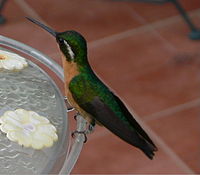Grey-tailed mountaingem
| Grey-tailed mountaingem | |
|---|---|

| |
| Male | |
| Scientific classification | |
| Domain: | Eukaryota |
| Kingdom: | Animalia |
| Phylum: | Chordata |
| Class: | Aves |
| Clade: | Strisores |
| Order: | Apodiformes |
| Family: | Trochilidae |
| Genus: | Lampornis |
| Species: | L. cinericauda
|
| Binomial name | |
| Lampornis cinericauda (Lawrence, 1867)
| |
The grey-tailed mountaingem or gray-tailed mountaingem (Lampornis cinereicauda) is a hummingbird which breeds only in the mountains of southern Costa Rica. Until recently it was believed to be a subspecies of the white-throated mountaingem.
This bird inhabits forested areas in hilly terrain, and is found at altitudes from 1850 m to the timberline in the Talamanca range. It is 10.5 cm long. The male weighs 6.2 g and the female 5 g. The shortish black bill is slightly curved.
The adult male grey-tailed mountaingem has bronze-green upperparts and underparts except for a brilliant green crown, pure white throat and grey tail. The female lacks the bright crown and throat, and has rich cinnamon underparts. Young birds resemble the female but have buff fringes to the upperparts plumage.

The female grey-tailed mountaingem is entirely responsible for nest building and incubation. She lays two white eggs in a deep plant-fibre cup nest 1–3 m high in a scrub. Incubation takes 15–19 days, and fledging another 20–26.
The food of this species is nectar, taken from a variety of small flowers, including epiphytic Ericaceae and bromeliads. Like other hummingbirds it also takes small insects as an essential source of protein.
Male gray-tailed mountaingems defend flowers and scrubs in their feeding territories, and are dominant except at higher levels where the range overlaps with fiery-throated hummingbird. The call of this species is a sharp pick or zeet.
The species is rated as Least Concern by the IUCN.
References
- ^ "Lampornis cinereicauda". IUCN Red List of Threatened Species. Retrieved 1 January 2015.
- García-Moreno, Jaime; Cortés, Nandadeví; García-Deras, Gabriela M. & Hernández-Baños, Blanca E. (2006): Local origin and diversification among Lampornis hummingbirds: A Mesoamerican taxon. Molecular Phylogenetics and Evolution 38(2): 488–498. doi:10.1016/j.ympev.2005.08.015 (HTML abstract)
- Stiles, F. Gary & Skutch, Alexander F. (1990): A guide to the birds of Costa Rica. Cornell University Press. ISBN 0-8014-9600-4
External links
- Variable Mountain-gem videos on the Internet Bird Collection

